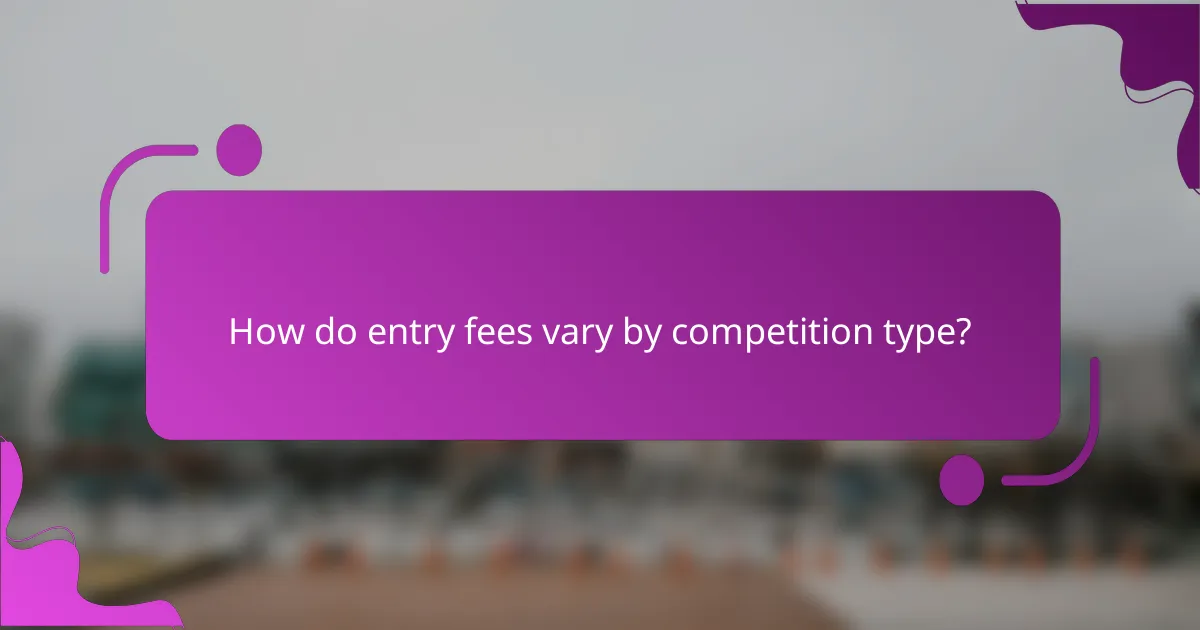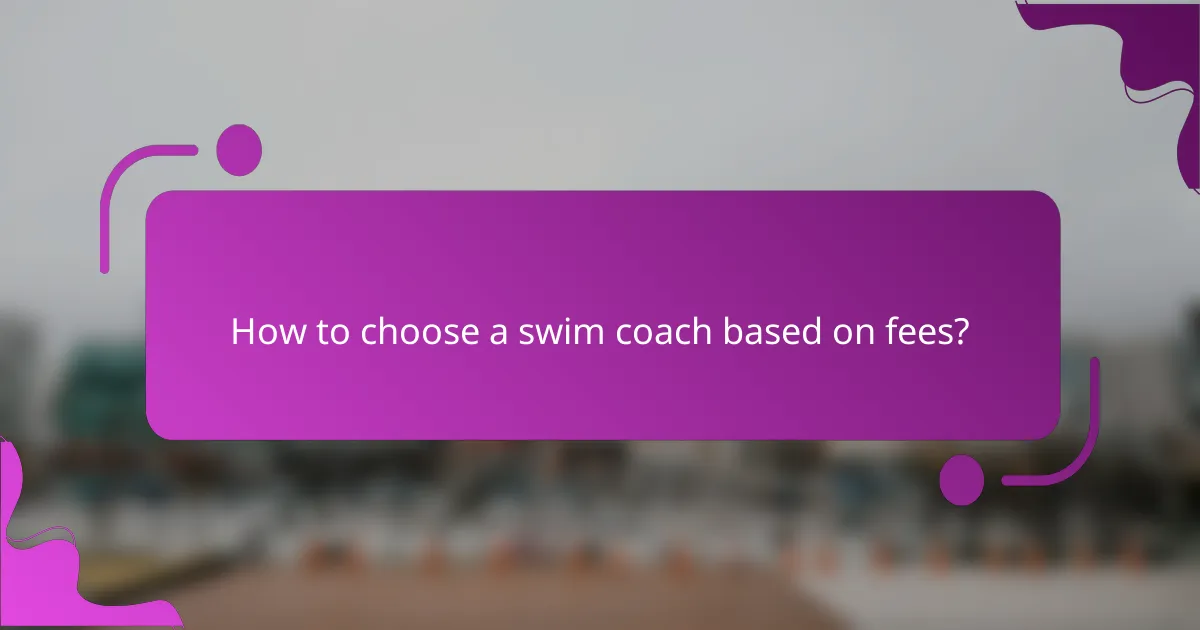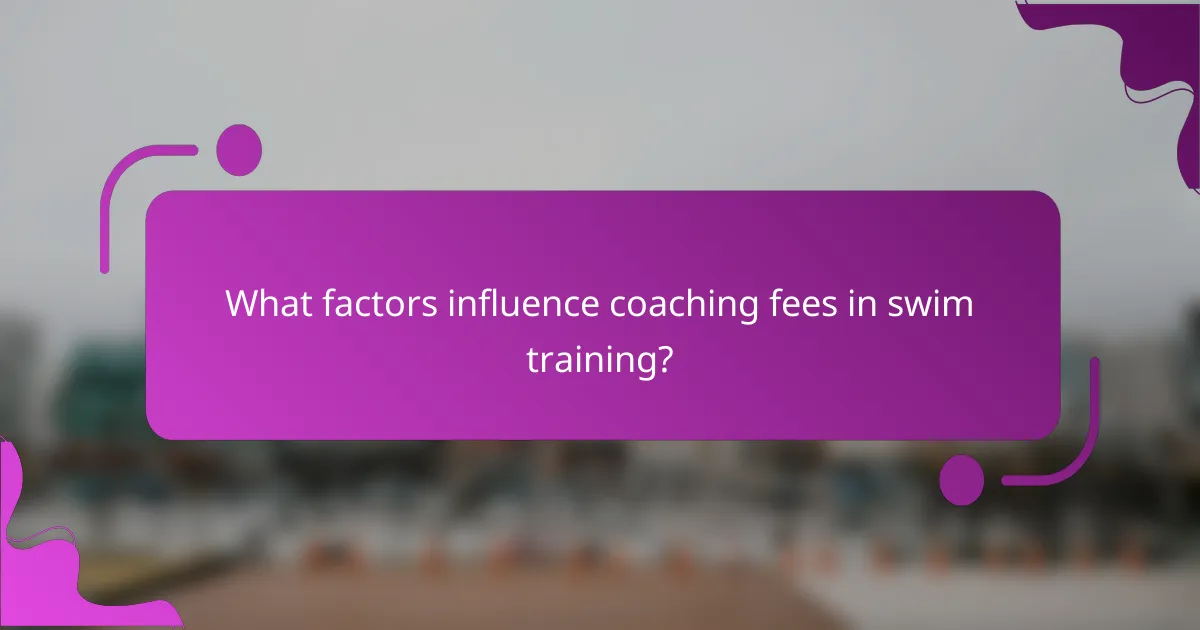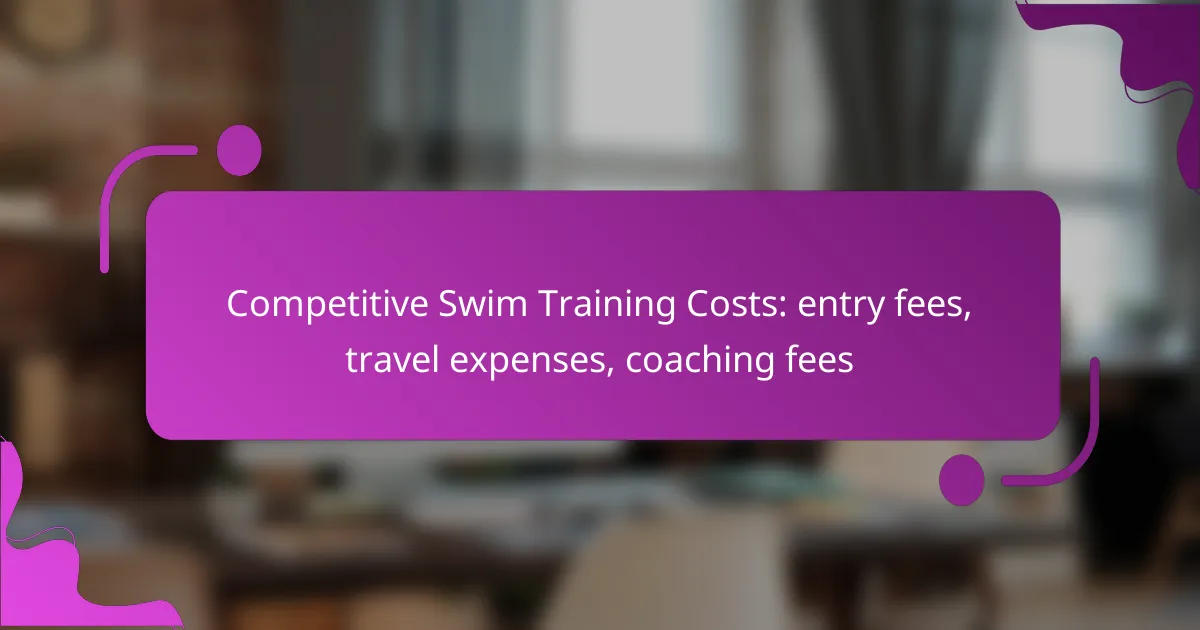Competitive swim training involves various costs that can add up quickly, including entry fees, travel expenses, and coaching fees. Families and athletes must navigate these expenses to effectively budget for their swimming commitments, as costs can vary widely depending on the level of competition and location. Understanding these financial aspects is crucial for anyone involved in the sport.

What are the typical costs of competitive swim training in Australia?
The costs associated with competitive swim training in Australia can vary significantly based on several factors, including entry fees, travel expenses, and coaching fees. Understanding these costs is essential for families and athletes looking to budget effectively for their swimming commitments.
Entry fees for competitions
Entry fees for swim competitions in Australia typically range from AUD 10 to AUD 30 per event, depending on the level of competition and the organizing body. Major competitions, such as state or national championships, may charge higher fees, sometimes exceeding AUD 50 per event.
It’s important to consider that some clubs may require additional fees for membership or participation in specific events. Always check with your local swim club for a detailed breakdown of costs associated with competitions.
Travel expenses for events
Travel expenses for swim events can vary widely based on the location of the competition. For local meets, costs might be minimal, covering only fuel or public transport fares, while state or national events may require flights, accommodation, and meals, potentially totaling several hundred to over a thousand AUD.
When planning for travel, consider factors like distance, duration of stay, and whether you will need to book accommodations. Group travel with teammates can sometimes reduce costs, so explore options for carpooling or shared lodging.
Coaching fees for swim training
Coaching fees for competitive swim training in Australia generally range from AUD 50 to AUD 100 per week, depending on the coach’s experience and the training program’s intensity. Some clubs offer tiered pricing based on the level of training, with more advanced squads costing more.
In addition to weekly fees, some clubs may charge for additional services such as strength training or specialized clinics. It’s advisable to review the club’s fee structure and inquire about any hidden costs before committing to a program.

How do entry fees vary by competition type?
Entry fees for competitive swim training can differ significantly based on the type of competition. Local swim meets typically have lower fees compared to state championships and national competitions, which often involve higher costs due to their scale and prestige.
Local swim meets
Local swim meets generally have the most affordable entry fees, often ranging from $5 to $25 per event. These competitions are designed to encourage participation and development among swimmers of all ages and skill levels. They usually attract local clubs and provide a friendly environment for athletes to gain experience.
When participating in local meets, it’s essential to check if there are any additional fees, such as facility charges or membership dues, which can add to the overall cost.
State championships
State championships typically have higher entry fees, often between $25 and $75 per event. These competitions are more competitive and may require qualifying times, which can add pressure but also provide valuable experience. The fees contribute to the organization of the event, including venue costs and awards.
Swimmers should be aware of potential travel expenses, as state championships may be held in different cities, necessitating accommodations and transportation costs.
National competitions
National competitions usually come with the highest entry fees, often ranging from $75 to over $200 per event. These events attract top-tier athletes and require rigorous qualification standards. The fees support extensive event logistics, including high-quality facilities and professional timing systems.
In addition to entry fees, swimmers should budget for significant travel expenses, including flights, hotel stays, and meals, which can substantially increase the overall cost of participation in national competitions.

What are common travel expenses for competitive swimmers?
Common travel expenses for competitive swimmers include accommodation, transportation, and meal costs during events. These expenses can vary significantly based on the location of the competition, duration of stay, and personal preferences.
Accommodation costs
Accommodation costs for competitive swimmers can range from budget-friendly options like hostels to more expensive hotels. Prices typically vary by location; for instance, staying near a major event venue may cost more than options further away. Booking in advance can often yield better rates.
Consider sharing rooms with teammates to reduce costs. Many teams also have preferred hotels that offer discounts for groups, which can help manage expenses effectively.
Transportation options
Transportation expenses can include airfare, car rentals, and local transit. Airfare can fluctuate widely, so booking early or using travel rewards can be beneficial. For local travel, options like buses, taxis, or rideshare services are common, and costs can add up depending on the distance traveled.
When traveling with a team, coordinating group transportation can save money. Additionally, consider the convenience of staying close to the event venue to minimize transportation needs.
Meal expenses during events
Meal expenses during events can vary based on dietary preferences and location. Eating out at restaurants can be costly, so budgeting for meals is essential. Many swimmers opt for grocery shopping to prepare their own meals, which can be more economical.
Plan for a daily meal budget that accommodates snacks and hydration, as these are crucial for performance. Look for local grocery stores or markets to find affordable options while traveling.

How to choose a swim coach based on fees?
Choosing a swim coach based on fees involves comparing the costs of coaching services while considering the value of their qualifications and the training programs they offer. It’s essential to find a balance between affordability and the quality of coaching to ensure effective training.
Comparing coaching rates
Coaching rates can vary significantly depending on the coach’s experience, location, and the type of training provided. On average, you might expect to pay anywhere from $30 to $100 per hour for private coaching sessions. Group sessions may be more economical, often ranging from $15 to $50 per swimmer.
When comparing rates, consider the frequency of sessions and any additional costs, such as facility fees or equipment. Some coaches may offer package deals that reduce the overall cost per session, which can be beneficial for long-term training commitments.
Evaluating coach qualifications
Assessing a coach’s qualifications is crucial when choosing based on fees. Look for certifications from recognized organizations, such as USA Swimming or the American Swim Coaches Association, which indicate a level of professionalism and expertise. Experience coaching at competitive levels can also be a significant factor.
Don’t hesitate to ask potential coaches about their training philosophy and past successes with swimmers. A higher fee may be justified if the coach has a proven track record of developing competitive swimmers.
Assessing training programs offered
The training programs offered by a coach can greatly influence their fees. Some coaches may provide specialized training for different skill levels, while others might focus on specific aspects like technique, endurance, or competition preparation. Understanding what is included in the training program is essential.
Inquire about the structure of the training sessions, the coach’s approach to athlete development, and any additional resources provided, such as video analysis or nutrition guidance. A comprehensive program may come at a higher cost but can offer greater value in terms of overall swimmer development.

What factors influence coaching fees in swim training?
Coaching fees in swim training are influenced by several factors, including the coach’s experience, the location of training sessions, and whether the coaching is conducted in a group or privately. Understanding these elements can help swimmers and their families make informed decisions about their training expenses.
Experience level of the coach
The experience level of a coach significantly impacts their fees. Coaches with extensive backgrounds, such as competitive swimming experience or certifications, typically charge higher rates due to their expertise and proven track record. For instance, a coach with national-level experience may charge between $50 to $150 per hour, while a less experienced coach might charge $30 to $60.
When selecting a coach, consider their qualifications and past successes. Investing in a highly skilled coach can lead to better training outcomes, potentially justifying the higher cost.
Location of training sessions
The geographical location of training sessions plays a crucial role in determining coaching fees. In urban areas with higher living costs, coaching fees tend to be more expensive compared to rural locations. For example, a coach in a major city may charge $100 per hour, whereas a coach in a smaller town might charge around $40.
Additionally, consider travel expenses if training occurs at a facility far from home. These costs can add up quickly, so factor them into your overall budget when planning swim training.
Group vs. private coaching
Group coaching sessions are generally more affordable than private coaching. In group settings, fees can range from $15 to $40 per session, allowing swimmers to benefit from coaching while sharing costs with others. This option is ideal for those on a tighter budget or who enjoy a team environment.
Conversely, private coaching offers personalized attention and tailored training plans, but at a higher cost. Private sessions may range from $50 to $150 per hour. Weigh the benefits of individualized coaching against the financial implications to determine the best fit for your training needs.

What are the long-term costs of competitive swim training?
The long-term costs of competitive swim training can be significant and vary widely based on factors like location, level of competition, and individual needs. Key expenses include annual training fees, equipment purchases, and ongoing competition costs.
Annual training expenses
Annual training expenses typically encompass coaching fees, pool access, and team membership dues. Depending on the region and training intensity, these costs can range from a few hundred to several thousand dollars each year.
Coaching fees often represent the largest portion of these expenses, with rates varying based on the coach’s experience and the training program’s prestige. It’s advisable to compare different programs and understand what each fee covers to make an informed decision.
Equipment costs for swimmers
Swimmers require specific gear, including swimsuits, goggles, caps, and training aids like kickboards and fins. Initial equipment costs can range from $100 to $500, depending on the quality and brand.
As swimmers grow and progress, they may need to replace gear more frequently, especially competitive swimsuits, which can be quite expensive. Investing in durable, high-quality equipment can save money in the long run.
Ongoing competition fees
Ongoing competition fees include entry fees for meets, travel expenses, and accommodation costs. Entry fees can range from $10 to $100 per event, while travel expenses vary significantly based on distance and frequency of competitions.
Parents should budget for both local and out-of-town meets, as travel can add up quickly. It’s wise to plan ahead and look for ways to minimize costs, such as carpooling with other families or seeking accommodations that offer group rates.
